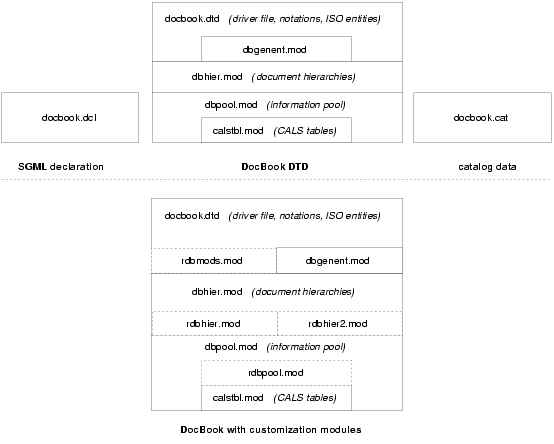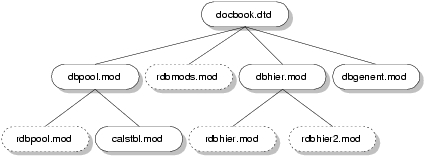Whole document tree
DocBook Architecture
The architecture of the DocBook DTD is modular and parameterized so that people who read and use DocBook and who interchange DocBook documents can more easily do the following:
Customize DocBook in appropriate ways
Maintain variant DTDs over time with as high a degree of fidelity to the original as possible
Determine exactly what is different between the original and a variant
Even if you intend to use DocBook in its original form, you need to understand how all the files go together. Figure 2-1 shows stacked boxes that represent the interdependencies of all the files that make up the distributed DocBook V2.4 application, as well as the files that can be supplied to create a "customization layer" on top of the DTD. Upper modules depend on lower ones.
Figure 2-2 shows the "call tree" (entity referencing structure) of the DTD modules, with the order of references shown left to right. Modules related exclusively to customization are shown with dashed lines; these need not be supplied if you are not customizing DocBook, and may not even need to be supplied for most simple customizations.
The contents and function of the files that make up the DocBook application are as follows. For V2.4.1 of DocBook, the formal public identifiers of the DocBook modules should use the version string "V2.4.1".
- docbook.dcl
This file contains an SGML declaration developed for DocBook, which depends on certain SGML declaration characteristics being set. You may need to change this declaration to suit your particular documents and processing applications; if so, it is a good idea to document what you've changed using comments.
- docbook.dtd
This driver file declares data content notations and declares and references the two main modules and the ISO standard entity sets. The driver file can be thought of as "the DocBook DTD." If you reference the driver file, declare it with the formal public identifier "-//Davenport//DTD DocBook version//EN".
Note that the driver file declares and references the nineteen ISO entity sets that appear in an annex to ISO 8879. It is assumed that your environment has these entity set files available. (The DocBook catalog data file (docbook.cat) has entries for these entity sets.) If you do not have these files, you can get them from the Davenport archive.
- dbhier.mod
This module contains the declarations related to the document hierarchical structure of DocBook documents: sets, books, reference entries, sections, articles, and so on. It is stored in a separate module in order to ease the process of reusing the information pool with a completely different document hierarchy. If you reference this module directly, declare it with the formal public identifier "-//Davenport//ELEMENTS DocBook Document Hierarchy version//EN".
- dbpool.mod
This module contains the declarations related to the information pool of DocBook documents, such as paragraphs, command names, and index terms. Here is where most of the parameter entities for element classes (such as "lists") and mixtures (such as the "component mixture") are set up, as well as the entities for common attributes. It is stored in a separate module in order to ease the process of reusing the information pool with a completely different document hierarchy. If you reference this module directly, declare it with the formal public identifier "-//Davenport//ELEMENTS DocBook Information Pool version//EN".
This module has dependencies on calstbl.mod and also has a few unavoidable dependencies on docbook.mod (which Figure 2-1 doesn't reflect). See the comments in the dbpool.mod file for more information.
- calstbl.mod
This module contains the CALS-based table model that DocBook uses. It is referenced directly by the information pool module, which parameterizes it by redefining various entities. If you reference this module directly, declare it with the formal public identifier "-//Davenport//ELEMENTS CALS-Based DocBook Table Model version//EN".
- dbgenent.mod
This file contains the declarations for any general entities (such as entities for special characters and boilerplate text) needed in your environment. The entity for this file is referenced in the DocBook driver file so that you can take advantage of it without having to do anything special to the original parts of the DTD, but the file provided as part of the distribution is empty except for an explanatory SGML comment. Its formal public identifier is "-//Davenport//ELEMENTS DocBook Additional General Entities//EN".
You can edit this file as necessary to add general entity declarations, or you can use the file as provided if you need no additional general entities. Note that you do not need to edit this file if you want to use only the ISO entity sets already referenced in the driver file. If you do edit the file, be sure not to overwrite it with the original file contents when you unpack new versions of DocBook.
- rdbhier.mod, rdbhier2.mod, rdbpool.mod, rdbmods.mod
These are the suggested names for the files that contain any customizations (entity redeclarations) that require the referencing of entities declared earlier in the DTD. You must declare these files as entities in your customization layer. If you declare these entities as PUBLIC entities, you will need to add the appropriate entries to the DocBook catalog data file (docbook.cat) or to another catalog file that you use.
These files exist only if you create them and declare their associated entities as part of a customization effort, and their contents will be unique to your customization. Note that many simple customizations do not require these files to be created.
- docbook.cat
This is a collection of catalog data in SGML Open TR9401 format, providing default filename locations as the "storage object identifiers" corresponding to the formal public identifiers by which DocBook modules should be identified. This file is provided as a convenience; you may need to incorporate this data into an existing catalog file or change the entries into a different format for use by your applications, and may need to change the storage object identifiers depending on the names, locations, and storage platforms of the DocBook files in your environement.


